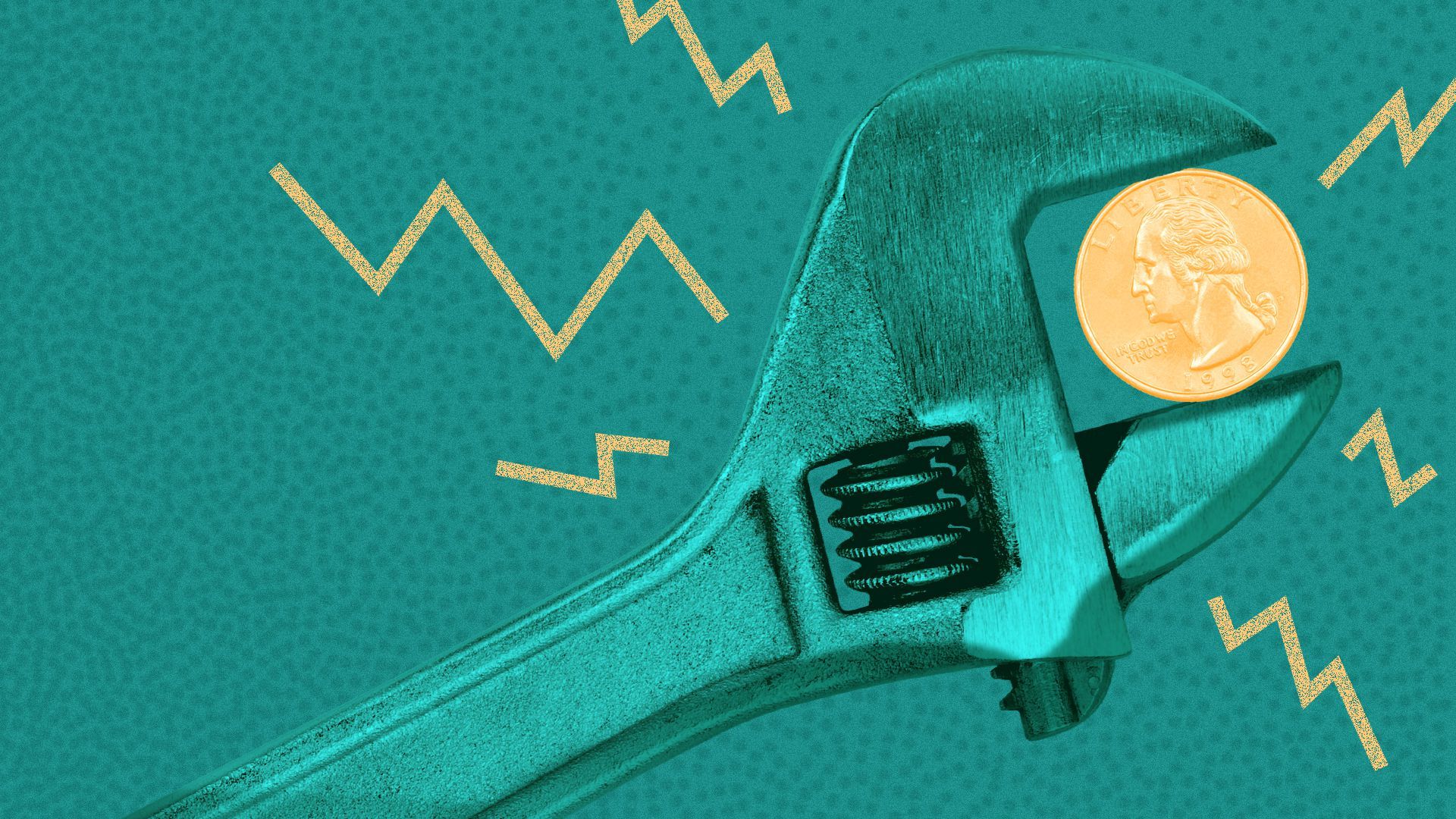| | | | | | | Presented By Panasonic | | | | Axios Macro | | By Neil Irwin and Courtenay Brown · Feb 16, 2023 | | Today brings more data showing price pressures intensified at the start of the year. Details below. - But first, a look at one possible solution for some of the U.S. economy's biggest woes. 💡
Situational awareness: Cleveland Fed president Loretta Mester said in a speech that there was a "compelling economic case" for the central bank to raise interest rates by a half-percentage point at the last policy meeting, rather than just a one-quarter point. - Mester, a non-voting member, also said this week's CPI report was a "cautionary tale against concluding too soon" that inflation will quickly recede.
Today's newsletter, edited by Javier E. David, is 619 words, a 2-minute read. | | | | | | 1 big thing: A trick for fixing inflation and debt |  | | | Illustration: Sarah Grillo/Axios | | | | The United States is suffering from rapid inflation, persistent labor shortages and — as new projections out yesterday show — public debt that's high and rising. - There's a pathway out that doesn't involve much pain, however: higher labor productivity.
Why it matters: If employers become more effective in converting labor hours into goods and services, as they have during past productivity spurts, it would enable robust growth. That would happen even in the face of deep demographic challenges that point to a shortage of necessary workers in the coming decade. By the numbers: The McKinsey Global Institute, the research arm of the giant consulting firm, has new research out today that crunches the numbers. - It finds that if U.S. productivity growth returned to its 2.2% per year average since 1948 as opposed to the (subpar) 1.4% rate notched between 2005 and 2019, it would add $10 trillion to cumulative economic output between now and 2030.
- That amounts to about $15,000 in additional output — and by extension, income — per household.
State of play: McKinsey's researchers find that even within the same industry, there are both high- and low-productivity companies. That implies some of this productivity growth could come from lower performers adopting best practices. - In manufacturing, for example, high-productivity companies achieve 5.4 times the economic output per hour of labor as the laggards.
- There are also stark U.S. regional divides, with California, Colorado, Massachusetts, New York, North Dakota, Texas, and Washington experiencing strong productivity growth.
Flashback: A productivity surge wouldn't be unprecedented. A notable jump took place from 1995 to 2005, driven in large part by companies digitizing their supply chains and other information technology advances. - "It's going to be hard, but we've done it before," Olivia White, a McKinsey senior partner and co-author of the report, tells Axios.
- "Technology matters, but our real focus is not just investing in technology, but unlocking the power of investments you've already made," White said. "That's what we saw in 1995 also. It's not a perfect parallel, but we see an analog right now."
Meanwhile, new projections from the Congressional Budget Office yesterday show the scale of the challenge America faces, with the national debt on track to soar from 98% to 118% of GDP over the coming decade. - CBO's economic projections assume labor productivity rises at only between 1.6% and 1.8% a year — in line with recent performance.
- That means if the economy turns out to function at something more like the 2.2% rate that McKinsey analyzed, the GDP denominator would be bigger, therefore lowering the debt ratio.
|     | | | | | | A message from Panasonic | | Deepening our commitment to sustainability | | |  | | | | Panasonic is helping lead the changes necessary to address the climate crisis. Here's how: From creating more sustainable business practices, products and solutions to helping our customers integrate sustainable technologies in their projects. Learn more. | | | | | | 2. Upside inflation surprise |  Data: Bureau of Labor Statistics; Chart: Axios Visuals There's more downbeat news on inflation this morning: Wholesale costs rose sharply in January, the latest indication of more persistent price pressures across the economy. - The producer price index, a measure of the change in costs of suppliers' goods and services, had been fairly benign in recent months, as supply chains healed and commodity costs came down. That changed last month.
Why it matters: The index is considered a leading indicator of what might happen to costs for consumers, as businesses pass along higher costs to shoppers. Details: The PPI rose 0.7% in January — the largest monthly jump since last summer, and a slightly quicker pace than analysts anticipated. The index is up 6% in the 12 months through January, compared to 6.5% in December. - Stripping out energy, food and trade service costs, the index rose 0.6%, compared to the 0.2% in December, the biggest monthly rise since last March.
The bottom line: The Fed "is hoping for supply chains to clear up and for finished goods prices to slow sharply—there is no sign of this in today's report," Brean Economics' John Ryding and Conrad DeQuadros wrote in a note. |     | | | | | | A message from Panasonic | | Driving the future of sustainable transportation | | |  | | | | As the leading electric vehicle (EV) battery manufacturer in North America, Panasonic continues to build on decades of battery expertise and technology innovation in the service of creating a greener, more equitable future. Learn how we're advancing the EV industry. | | |  | | Are you a fan of this email format? Your essential communications — to staff, clients and other stakeholders — can have the same style. Axios HQ, a powerful platform, will help you do it. | | | | | | Axios thanks our partners for supporting our newsletters.
Sponsorship has no influence on editorial content. Axios, 3100 Clarendon Blvd, Arlington VA 22201 | | | You received this email because you signed up for newsletters from Axios.
To stop receiving this newsletter, unsubscribe or manage your email preferences. | | | Was this email forwarded to you?
Sign up now to get Axios in your inbox. | | | | Follow Axios on social media:    | | | | | |





No comments:
Post a Comment
Keep a civil tongue.